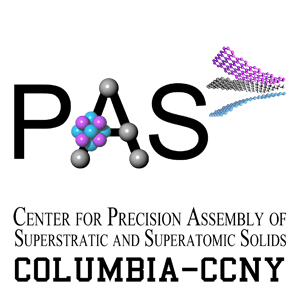Collaborations
Columbia-CCNY MRSEC

NSF MRSEC Center for Precision Assembly of Superstratic and Superatomic Solids (PAS3) is a joint center led by the City College of New York and Columbia University, with Harvard University, Barnard College, and the University of the Virgin Islands as additional partners. Krusin is a co-Director (with Hone at Columbia) of IRG1 (Heterostructures of van der Waals Materials) team, that includes Tamargo, Menon and Riedo groups as members. IRG1 assembles two-dimensional van der Waals materials into pristine layered heterostructures. The team has demonstrated successful collaboration to develop proof-of-concept heterostructures with unprecedented size, perfection, and complexity. Support for the center is provided through the NSF Grant DMR-1420634, part of the NSF MRSEC Program.
Visit PAS3 website http://mrsec.columbia.edu/
CREST-IDEALS

NSF CREST Center for Interface Design and Engineered Assembly of Low Dimensional Systems (IDEALS) comprises a diverse multidisciplinary team of CCNY researchers that has come together to design and discover materials with new and enhanced functionalities. The Center research activities are organized into three synergistic Subprojects: (1) Low-Dimensional Functional Materials and Nano-Heterostructures (led by Krusin), (2) Bio-inspired Re-configurable Materials, and (3) Novel Materials Probes and Design Formalism, with Menon, Meriles, Khanikaev participating in collaborative research. IDEALS is directed by Tamargo. Support for the center is provided through the NSF Grant HRD-1547830, part of the NSF CREST Program.
Visit CREST-IDEALS website https://idealscrest.org/
CDI

The City College Center for Discovery and Innovation opened in 2015 and features approximately 200,000 square feet of space for advanced research in key interdisciplinary fields. The facility is a magnet for regional, national and international researchers and an academic hub of learning for students and faculty.
ASRC
The ASRC NanoFab operates a 5,000 square-foot cleanroom in which advanced nanofabrication and characterization can be conducted in an environment where the levels of dust, airborne microbes, temperature, and humidity are controlled. The ASRC NanoFab is among the most advanced cleanroom facilities on the East Coast, meeting class 100, class 1,000 and class 10,000 standards, comparable to the one now closest, at Brookhaven National Laboratory.

The ASRC NanoFab contains a comprehensive toolset for lithography, thin film deposition, dry etching, metrology and characterization. Photolithography, electron beam lithography and 3D nanolithography tools are available for patterning at the micro and nano scales. Atomic force microscopy, optical and surface profilometry, variable temperature and angle spectroscopic ellipsometry, as well as scanning electron microscopy are also available. ASRC's thin film deposition techniques include magnetron sputtering, thermal and e-beam evaporation; plasma enhanced chemical vapor deposition, atomic layer deposition, and thermal processing furnaces. In addition, a comprehensive suite of plasma based cleaning and etching tools including a dedicated chlorine and fluorine inductively coupled plasma etchers and reactive ion etchers are maintained.
ASRC's major instruments include a high-end electron beam lithography writer, a field emission SEM, a chlorine based inductively coupled plasma etcher, a metal and oxide deposition equipment, advanced metrology equipment, and a three-dimensional micro and nano laser lithography system. This direct laser writing system allows for fabrication of complex shaped polymer structures with finest feature sizes in the sub-micrometer range. The ASRC NanoFab is also supported by an imaging suite, that consists of a cryogenic TEM for life sciences, a materials science TEM, a training TEM, and a dual beam SEM / FIB / Nanomanipulator system for sample preparation. For users, the NanoFab provides an opportunity to carry out hands on research with some of the world’s most sophisticated instruments for the fabrication and characterization of materials at the micro and nanoscale.
Visit ASRC website http://www.asrc.cuny.edu/


